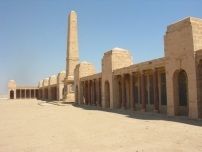| First Name: | James | Last Name: | PANKHURST | |
|---|---|---|---|---|
| Date of Death: | 05/03/1917 | Lived/Born In: | St. Luke's | |
| Rank: | Shoeing Smith | Unit: | Hussars13 | |
| Memorial Site: | Basra Memorial, Iraq | |||
Current Information:35, Radnor Street, St Luke's
When the Ottoman Empire allied itself to Germany in 1914, Britain found herself at war with Turkey, a war that was not only fought in Gallipoli, Egypt and Palestine, but also in Mesopotamia, the land between the rivers Tigris and Euphrates which is now modern day Iraq. Britain had vital oil interests around Basra in the south and troops were sent there to protect them. During 1915 and 1916, British and Indian troops began pushing north with their eye on the prize of Baghdad, which after a series of victories and reverses was finally captured in March 1917. But the Turks continued to strenuously defend their territory until the final end came in October 1918, when they signed an armistice. At the beginning of March, 1917, as the British forces closed in on Baghdad, the 13th Hussars of the 7th Cavalry Brigade, 2nd Indian Cavalry Division, were in bivouacs at Aziziyah on the River Tigris. On 5th March they moved north with the Division with orders to camp at Lajj. 7th Indian Cavalry Brigade were leading with Watsons Horse in front and 13th Hussars behind them. In the afternoon the advanced guard reported an enemy convoy on their right front and armoured cars and planes reported small patrols of scattered infantry. 13th Hussars were ordered to support Watsons Horse who were coming under fire and A and B squadrons moved forward to prolong the right flank. Here they came under sharp fire so they dismounted and engaged the enemy for fifteen minutes before being recalled. A further enemy force was spotted about one mile to the north and C squadron were sent to to make a detour to the east and assist on the right flank while A, B and D squadrons moved forward at a trot under inaccurate shell fire. Casualties were sustained but these came from rifle fire from infantry concealed in nullahs (dried river beds) and trenches in front. Despite a high wind and accompanying dust which made it difficult to read signals, the advance changed to a gallop with swords drawn and the order to charge was given. They swept over three lines of Turkish infantry who kept up a heavy fire until the last moment but it was realised that the mounted attack could not be continued so they wheeled to the right and retired. Many Turks, who had been passed over picked up their arms again and resumed firing, some with heavy machine-guns. Once clear of this fire the cavalrymen dismounted and prepared for action but this was hampered by the many casualties that had been incurred. Nevertheless 13th Hussars advanced on foot and succeeded in getting a footing in one of the nullahs where they consolidated. There was still heavy fire on this new position from the left and at 6.30pm, as darkness fell, the retirement began but it was difficult bringing back the wounded. C Squadron had been prevented from getting near to the enemy by small parties of infantry and they now returned to Brigade HQ. Total casualties for 13th Hussars had been over 80 as well as 54 horses killed. One of the casualties was James Pankhurst. |
||||
| « Back to Search Results | ||||
| If you think any of the information shown here is incorrect, Click Here to submit your amends and comments | ||||




